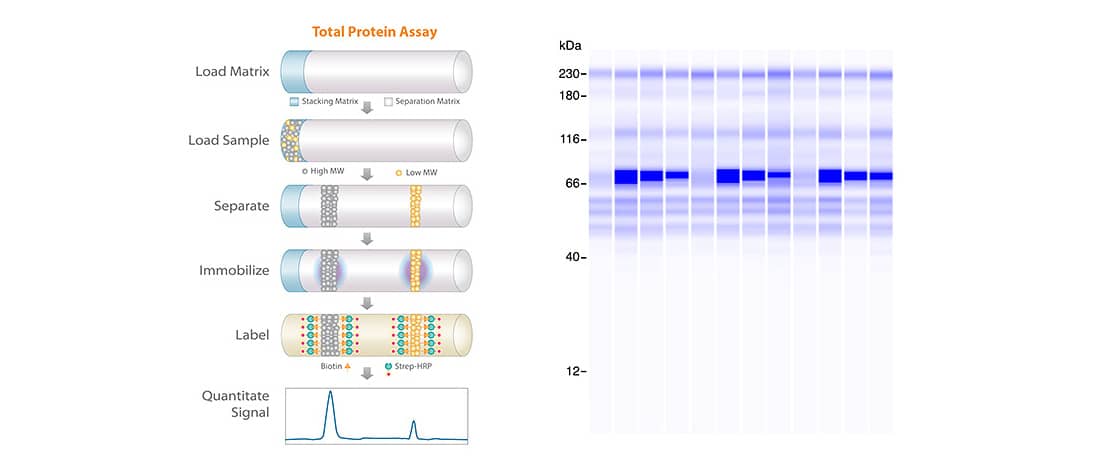Simple Western Size-Based Total Protein Assays
Interested in looking at all the proteins in your lysate? Simple Western™ can do the work for you. Use your total protein assay data to identify impurities or contaminants in your sample or normalize your immunoassay data with total protein measurements for more reliable results.
Table of Contents:
There are 3 main detection options available for total protein analysis on Simple Western:
- Chemiluminescent Total Protein Assay Methods
- Total Protein Assay Methods with RePlex™
- Fluorescent Total Protein Assay Methods
Total protein normalization is a technique where target protein abundance is normalized to the overall amount of protein present in a sample rather than a housekeeping protein to minimize the impact of varying expression of a loading control. Total protein normalization is increasingly required for western blotting data by academic journals and grant agencies due to the improved reliability of normalized expression values. Download our white paper to learn more about Simple Western publication-ready results.
Chemiluminescent Total Protein Assay
The Chemiluminescent Total Protein Assay can be used to detect all the proteins in your lysate, similar to a Coomassie or SYRPO Ruby stained gel. Sample preparation, separation, and immobilization for the Chemiluminescent Total Protein Assay are exactly the same as Simple Western automated immunoassays. But, instead of specifically detecting your protein of interest with a primary antibody, the Chemiluminescent Total Protein Assay attaches biotin to all the proteins in your sample. Incubation with Streptavidin-HRP followed by Luminol/Peroxide generates a chemiluminescent signal for the total captured protein. The Total Protein Detection Module includes the reagents required to do a Chemiluminescent Total Protein Assay (Separation Module sold separately).
Stellar™ NIR / IR detection modules for Jess set the industry standard for Western blotting fluorescence detection sensitivity. Stellar fluorescence modules enable detection of low abundance proteins and multiplexing of multiple targets, including multi-color immunoassays alongside Stellar Total Protein Staining within the same lane. The formulation of the Stellar Total Protein Detection Module (DMTP03) is unique to Stellar fluorescence assays on Jess and is different from the Total Protein Detection Module (DM-TP01).
More Sensitive Than SYPRO Ruby
The sensitivity of Simple Western Total Protein Assays can be adjusted based on the needs of your sample by adjusting the concentration of Biotin Labeling Reagent. Using 5 times more concentrated Biotin Labeling Reagent, total protein detection using Simple Western can surpass the sensitivity of SDS-PAGE total protein stains including SYPRO Ruby. While SYPRO Ruby requires at least 1 ng of protein for reliable detection, Simple Western Total Protein Assay Methods using 5X Biotin Labeling Reagent can reliably detect as little as 150 pg. Download the Total Protein Assay for AAV Analysis App Note to learn more about the use of ultra-high sensitivity total protein assays for AAV analysis in the development of cell & gene therapies.

Side-by-side comparison of Simple Western Total Protein Assay for AAV Analysis using SYPRO Ruby (right) and 5X Biotin Labeling Reagent with Simple Western (left) shows that the Simple Western Total Protein Assay surpasses the sensitivity of traditional protein stains.

Chemiluminescent Total Protein Detection on Simple Western. Decreasing concentrations of recombinant DnaK (15 µg/mL, 7.5 µg/mL, and 3.75 µg/mL) in HeLa whole-cell lysate and negative controls.
Total Protein Normalization Using RePlex

Chemiluminescent Total Protein Assays can also be used to normalize immunoassay data using RePlex on Abby or Jess instruments. For samples containing 0.005 - 0.2 mg/mL of protein, chemiluminescence total protein assay methods can get you accurate normalized immunoassay data without having to rely on variable housekeeping proteins. For samples containing 0.2 – 1.2 mg/mL of protein, a fluorescent total protein assay can be run on Jess using the Fluorescent Protein Normalization Assay Module (see next section on Fluorescent Total Protein Assays).
Fluorescent Total Protein Assay
The Protein Normalization Assay Module on Jess enables you to run a fluorescent total protein assay in the same capillary on the same sample, without sacrificing your NIR, IR or Chemiluminescent detection channels. After separation & immobilization of your sample proteins, the Protein Normalization Assay Module for Simple Western uses a proprietary molecule to fluorescently label proteins in your sample for detection. The Protein Normalization Assay Module is appropriate for samples containing 0.2 – 1.2 mg/mL of protein and comes with both a separation module and the reagents required to do a total protein assay.
Figure: Lane view of protein normalization in Compass for Simple Western. Shown are three options for visualization: the traditional total protein "membrane stain" (left); dot overlay of the raw total protein area measured in each "lane" (middle); dot overlay of the normalized percent total protein area measured relative to the chosen reference "lane" or capillary (right), in this case, the 1-mg/mL sample.
